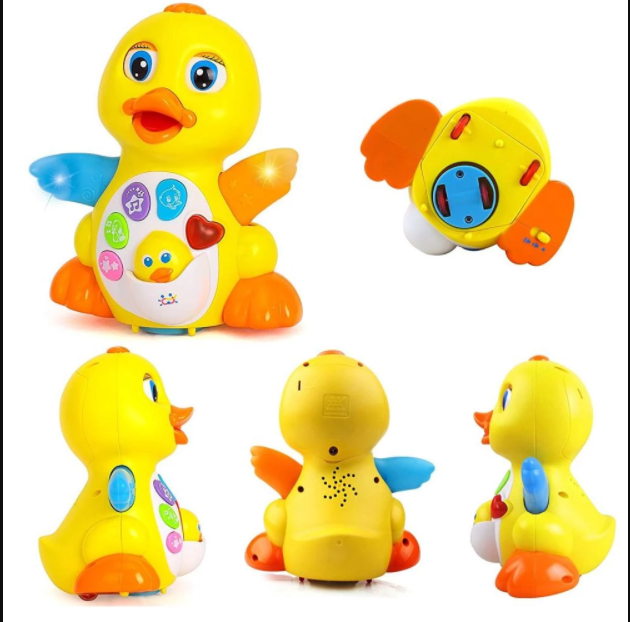Learning through play is a very important component of a child’s growth. Educational toys tend to help develop problem-solving skills, understand the causes and impacts, and resolve conflicts. Learning through play also helps children determine the importance of sharing. It also promotes creativity and imagination. Children are taught to share the same toys with their friends as they maintain their focus on their objectives. The benefits brought by children’s games and toys have made psychologists acknowledge the importance of board games in the development of children. While playing their games, children start to collaborate with their friends and have fun (Eriksson et al., 2019). A situation where children come together to achieve a fun activity is referred to as cooperative play, and it mostly occurs with children between the age of 4 to 6.
Joy in Dancing Walking Yellow Duck Baby Toy with Music is a fun game for toddlers that educates them on various basic abilities such as singing, dancing, taking turns, color recognition, and matching. Older youths are willing to participate in the game with the younger toddlers. This game promotes cognitive and sensory development since children can sing, dance, and develop their matching skills and color learning skills. The songs and sounds build on the child’s listening and sense of rhythm and music. These games consist of a dancing ducky with five buttons used to play seven melodies. The buttons are also used to generate heartbeats activate melodies, and flashlights. For the purposes of motor skills, the ducky moves in a waddle with lights enticing a baby to crawl and move in their direction. The toy is equipped with all the features that can improve the baby’s sensory development, motor skills, and auditory skills.
The target range for this game is kids between the age of four and six, and the parents of the kids can also participate in the game. The gender of this game is both boys and girls, and it has a manufacturing claim that educates the parents of the child before playing the game. This is so that the manufacturer can warn the parents of the risks associated with the toys. Choosing this type of game will help every child improve their psychological, cognitive, and physical aspect. From the psychological aspect, this game is entertaining enough in that older kids can play the game with their younger children. It also teaches children how to deal with failure once they are defeated without losing their cool. It is guaranteed that playing this type of game brings joy to every child who participates in it. Endorphins, which are the body’s natural chemicals released when a child is playing games, are produced, making the child feel great and have fun (Zuhdiyah et al., 2020). Playing games helps children develop their social skills as they learn how to regard their friends’ viewpoints and feelings and resolve conflicts and cooperate. As children engage in playing games, they can comprehend their own emotions and how their actions might affect other people.
In the cognitive aspect, toys are manufactured to aid in solving problems. In this case, the young toddlers understand the importance of numbers one and two. Their memories are also improved as it helps them remember the colors involved in the game. Children are fascinated by colors enticing them to play the games, thus improving their cognitive abilities. This is because games and toys are known to improve kids’ attention span, perseverance, memories, and their perseverance to focus. As a parent, keep in mind the child’s level of development when choosing any type of game or toy.
Toys are an important part of a child’s development but come with danger. It is risky to buy toys for children below the age of three since they risk getting choked because they tend to put everything in their mouths. Therefore, parents need to inspect the toys and watch them play (Gibson, 2021). Educational toys that are informative might help young toddlers learn a wide range of abilities that are applicable throughout their lives as adults. The toys can also aid in the improvement of problem-solving abilities as the children relate with other people.
Children can improve their decision-making and understanding of various sounds. The game boosts individuals’ connection with their parents and enables them to communicate effectively as they play the game. People also have the ability to improve their logical reasoning as they work in tandem with their parents to develop their positive traits. It is important to discern that individuals can choose from this form of knowledge and avoid some issues that would otherwise alleviate their capacity to learn about the world based on their age.
The toy manufacturers should focus on developing a product that includes parents. While a child could play with the toy, they should be inclined to share the joy with others. By allowing others to participate in the activity, the child would gain cognitive skills that propagate teamwork and work with others.
References
Eriksson, E., Baykal, G. E., Björk, S., & Torgersson, O. (2019). Using gameplay design patterns with children in the redesign of a collaborative co-located game. In Proceedings of the 18th ACM International Conference on Interaction Design and Children, pp. 15-25.
Gibson, R. (2021). ¡Canta Conmigo!: Songs and Singing Games from Guatemala and Nicaragua. Oxford University Press.
Zuhdiyah, Z., Karolina, A., Oviyanti, F., Aflisia, N., & Hardiyanti, Y. S. D. (2020). The Variousity of Happiness Perspective and Its Implementation in Learning Process. Psikis: Jurnal Psikologi Islami, 6(1), 102-115.
Appendices
Appendix A

